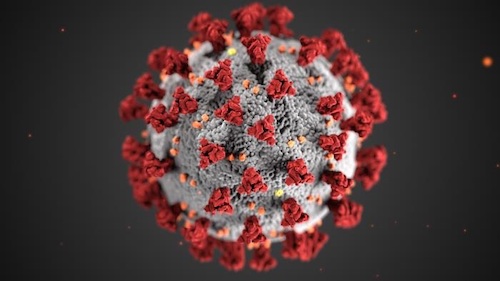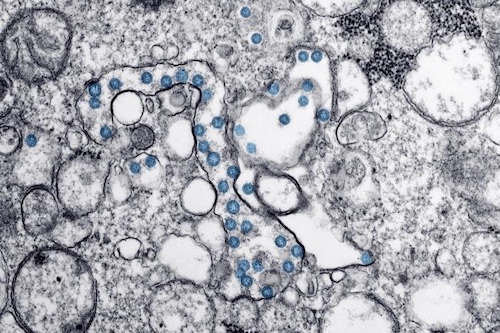 According to the Centers for Disease Control and Prevention (CDC), this illustration "reveals ultrastructural morphology exhibited by coronaviruses…A novel [new] coronavirus, named Severe Acute Respiratory Syndrome coronavirus 2 (SARS-CoV-2), was identified as the cause of an outbreak of respiratory illness first detected in Wuhan, China in 2019. The illness caused by this virus has been named coronavirus disease 2019 (COVID-19)." (The image was produced by Alissa Eckert and Dan Higgins and was provided courtesy of the CDC, 2020.)
According to the Centers for Disease Control and Prevention (CDC), this illustration "reveals ultrastructural morphology exhibited by coronaviruses…A novel [new] coronavirus, named Severe Acute Respiratory Syndrome coronavirus 2 (SARS-CoV-2), was identified as the cause of an outbreak of respiratory illness first detected in Wuhan, China in 2019. The illness caused by this virus has been named coronavirus disease 2019 (COVID-19)." (The image was produced by Alissa Eckert and Dan Higgins and was provided courtesy of the CDC, 2020.)
A pandemic has been part of the daily news for people of Grant County for weeks now. During this time, there have been questions of what to call the disease and virus causing this pandemic.
Officially, the name of the disease is "COVID-19."
You might wonder how it got its name or why many officials use that name instead of other names. The coronavirus disease that was first seen in 2019 was named "COVID-19" by using the words COronaVIrus Disease 2019.
That is the name of the disease.
The disease itself is caused by the "Severe Acute Respiratory Syndrome COronaVirus 2 (SARS-CoV-2)."
One name for the disease – COVID-19; another name for the virus that causes the disease – SARS-CoV-2. (There is actually a third name – the one for the viral species that includes this virus – "SARS.")
The World Health Organization (WHO) used the analogy that "People often know the name of a disease, such as measles, but not the name of the virus that causes it (rubeola)."
Such is the case with COVID-19.
Prior to February of 2020, neither the disease or the virus had "official" names.
(Yes, there are entities entrusted to "officially" name such items.)
On February 5, 2020, the International Committee on Taxonomy of Viruses (ICTV) announced that it had named the virus "SARS-CoV-2." The ICTV indicated in the same announcement that expert virologists in the "ICTV Coronaviridae Study Group…determined the virus belongs to the existing species, Severe acute respiratory syndrome-related [SARS] coronavirus."
The WHO announced on February 11, 2020, that the name "COVID-19" was now the official name of the disease caused by SARS-CoV-2.
Initially, a number of people used the term "2019 novel coronavirus" to designate the disease. ("Novel" in this case means "new.") Other names were also used; some, based on geography.
It's not unusual for people to use location names as shorthand for names of items.
Roadways are a good example. Bayard Street in Santa Clara, for example, is named after the fact that it leads to Fort Bayard. Pinos Altos Road in Silver City is another example; the roadway leads to Pinos Altos from Silver City.
Locations can also be the source of disease names.
The "Spanish Flu" or the "Spanish Influenza" did not actually begin in Spain. But Spain was one of the first countries where the news media could report on the disease. Due to military censorship rules in effect during World War I, most members of the news media could not report on or did not know of the extent of the disease in other locales where it was spreading. Thus, people used "Spanish" in the name of the disease as shorthand when referring to the pandemic of 1918-1919.
According to the WHO, COVID-19 was first seen in the City of Wuhan in China. As such, some people initially called the disease the "Wuhan virus" or the "Chinese virus" because of that location.
People using "Wuhan" or "Chinese" to identify the disease were not necessarily being judgmental or racist. They were identifying a new ailment in a way that many humans name a wide variety of things. By location.
Consider the wording used in headlines by prominent American news media entities when referencing what became known as "COVID-19":
"First U.S. Case Reported of Deadly Wuhan Virus"
The Wall Street Journal, January 22, 2020
"Your Questions About Wuhan Coronavirus, Answered"
National Public Radio, January 30, 2020
"W.H.O. Declares Global Emergency as Wuhan Coronavirus Spreads"
The New York Times, January 30, 2020
"WHO says Wuhan coronavirus outbreak is not yet a pandemic"
CNN, February 4, 2020
"Chinese virus triggers outbreak of health hustles"
The Sunday Journal (Albuquerque), Front page of Business section, February 9, 2020
Consider the wording used in sub-headlines to link to news stories by prominent American news media entities when referring to what became known as "COVID-19":
"Asian demand for face masks soars due to fears of Chinese virus. A10"
Orlando Sentinel, Front page link to news story, January 31, 2020
"Poll: More Americans worry about flu than newly discovered Chinese virus / A4"
Arizona Daily Star, Front page link to news story, February 22, 2020
Consider the wording used in news articles by prominent American news media entities when referencing what became known as "COVID-19":
"Most of the patients with the Wuhan virus appear to have…"
Herald News (in northern New Jersey), January 18, 2020
"…for a vaccine as the Wuhan virus threatened to become a global crisis…"
The Philadelphia Inquirer, Front page of Business section, January 29, 2020
These examples – and there are many others – of how the news media detailed aspects of this disease reflect that members of the news media identified this new ailment in similar ways to how others identify a wide variety of things. By location.
On February 3, 2020, a reporter with Associated Press, Mr. Mike Stobbe, directly asked an official with the CDC why the disease was being called "2019 nCoV" rather than the "Wuhan virus": "Why isn't it called like Yamagata or in this case the Wuhan virus? Could you explain why that name in convention isn't being followed with this new coronavirus?"
(Yamagata is a city in Yamagata Prefecture [governmental administrative division similar to a state or province] in Japan. He was referring to the name of a virus, "Influenza B/Yamagata," used to identify a virus named after that Japanese community. The Indiana Gazette, of Pennsylvania, noted that there were three strains of influenza – "…the A-Taiwan, A-Shanghai, and B-Yamagata virus strains." – in a news article dated January 19, 1991. In a news article dated February 20, 1991, in The Los Angeles Times, note was made of "…the B Yamagata virus…")
In the transcript of that CDC Telebriefing, Dr. Nancy Messonnier, Director of the CDC National Center for Respiratory Diseases, indicated that "I think, the world's health organization said weeks ago that this 2019 novel coronavirus name was a temporary name. There are naming conventions and I suspect once people have a chance to catch their breath it will be changed. It's 2019 because that's when the outbreak was determined to start. I think that is just a temporary name. My understanding there are plans down the road to clean that up."
Please note: There is no question that some people who used or continue to use the wording "Wuhan virus" or "Chinese virus" did so or are doing so because of their racist beliefs. But not everyone who used those terms did so because of animosity or hatred.
Stating where something has occurred should reflect fact, not opinion. It is a fact, according to the WHO, that COVID-19 was first observed in the City of Wuhan in China.
That said, it is not a fact that everyone in Wuhan or in China or that individuals with Chinese heritage have or have had COVID-19.
COVID-19 and its underlying virus, SARS-CoV-2, do not know political boundaries. The virus does not discriminate on who has been or who might be infected. Race and ethnicity are immaterial to COVID-19 and its underlying virus.
Interestingly, while the WHO does want people to use the name "COVID-19" for the disease, the WHO indicated that it does not use "SARS-CoV-2" as the "official name" for the virus.
Its reasoning?
"From a risk communications perspective, using the name SARS can have unintended consequences in terms of creating unnecessary fear for some populations, especially in Asia which was worst affected by the SARS outbreak in 2003.
"For that reason and others, WHO has begun referring to the virus as 'the virus responsible for COVID-19' or 'the COVID-19 virus' when communicating with the public. Neither of these designations are intended as replacements for the official name of the virus as agreed by the ICTV."
Thus, the officials in charge of world health want you to use the "official name" for the disease – COVID-19 – but they themselves don't use the "official name" for the virus – SARS-CoV-2.
 The CDC indicated that this image shows the "transmission electron microscopic image of an isolate from the first U.S. case of COVID-19, formerly known as 2019-nCoV. The spherical viral particles, colorized blue, contain cross-sections through the viral genome, seen as black dots." (The image was produced by Hannah Bullock and Azaibi Tamin and was provided courtesy of the CDC, 2020.
The CDC indicated that this image shows the "transmission electron microscopic image of an isolate from the first U.S. case of COVID-19, formerly known as 2019-nCoV. The spherical viral particles, colorized blue, contain cross-sections through the viral genome, seen as black dots." (The image was produced by Hannah Bullock and Azaibi Tamin and was provided courtesy of the CDC, 2020.
Do you have questions about communities in Grant County?
A street name? A building?
Your questions may be used in a future news column.
Contact Richard McDonough at chroniclesofgrantcounty@mail.com.
© 2020 Richard McDonough